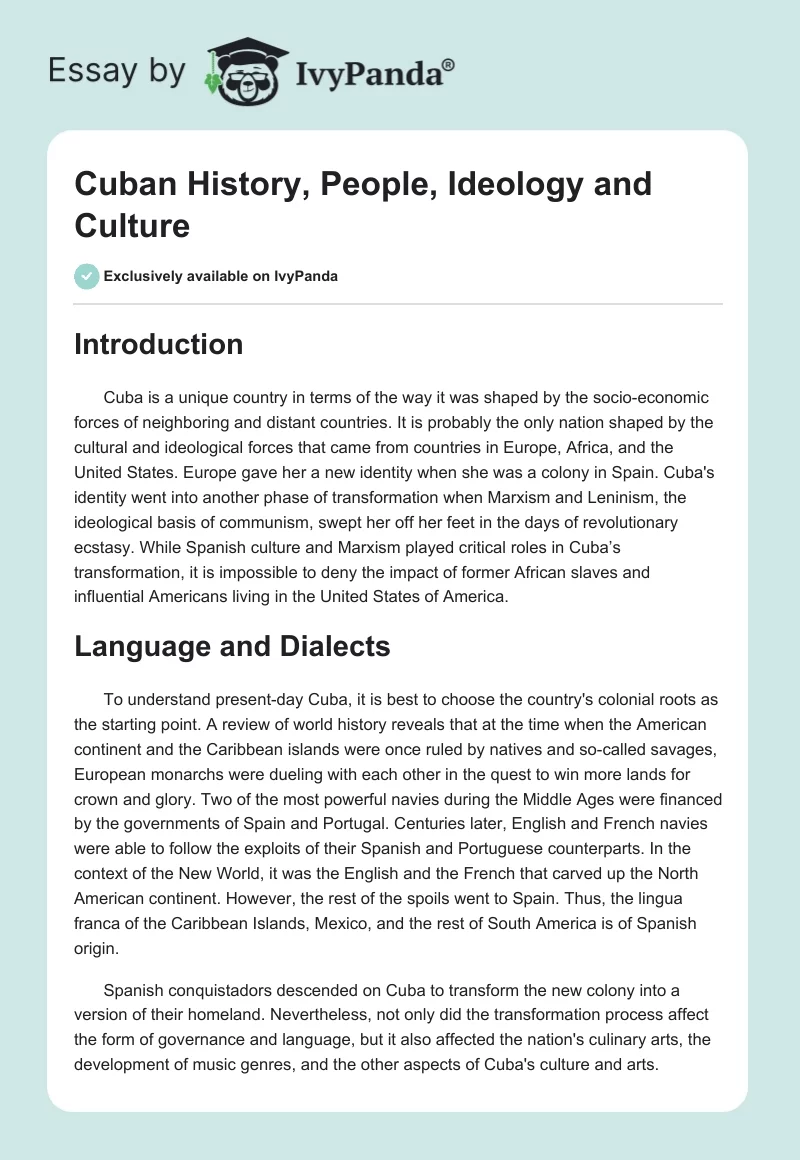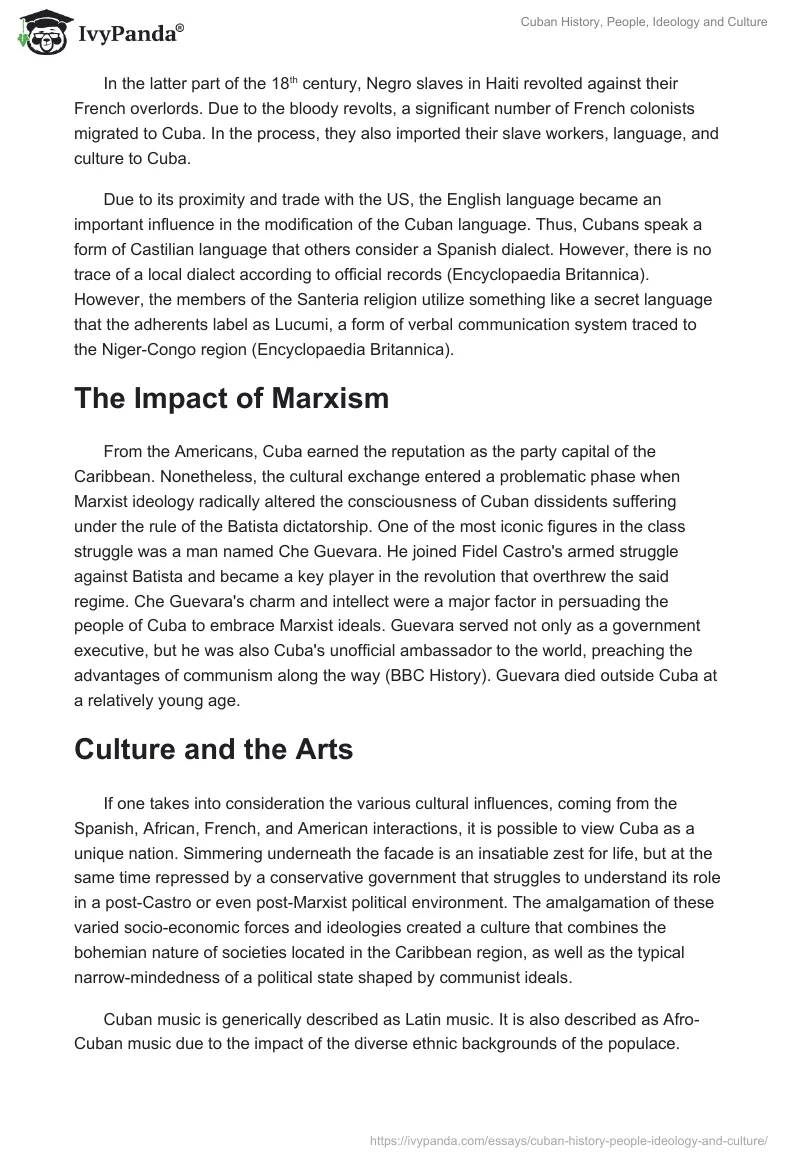Introduction
Cuba is a unique country in terms of the way it was shaped by the socio-economic forces of neighboring and distant countries. It is probably the only nation shaped by the cultural and ideological forces that came from countries in Europe, Africa, and the United States. Europe gave her a new identity when she was a colony in Spain. Cuba’s identity went into another phase of transformation when Marxism and Leninism, the ideological basis of communism, swept her off her feet in the days of revolutionary ecstasy. While Spanish culture and Marxism played critical roles in Cuba’s transformation, it is impossible to deny the impact of former African slaves and influential Americans living in the United States of America.
Language and Dialects
To understand present-day Cuba, it is best to choose the country’s colonial roots as the starting point. A review of world history reveals that at the time when the American continent and the Caribbean islands were once ruled by natives and so-called savages, European monarchs were dueling with each other in the quest to win more lands for crown and glory. Two of the most powerful navies during the Middle Ages were financed by the governments of Spain and Portugal. Centuries later, English and French navies were able to follow the exploits of their Spanish and Portuguese counterparts. In the context of the New World, it was the English and the French that carved up the North American continent. However, the rest of the spoils went to Spain. Thus, the lingua franca of the Caribbean Islands, Mexico, and the rest of South America is of Spanish origin.
Spanish conquistadors descended on Cuba to transform the new colony into a version of their homeland. Nevertheless, not only did the transformation process affect the form of governance and language, but it also affected the nation’s culinary arts, the development of music genres, and the other aspects of Cuba’s culture and arts.
In the latter part of the 18th century, Negro slaves in Haiti revolted against their French overlords. Due to the bloody revolts, a significant number of French colonists migrated to Cuba. In the process, they also imported their slave workers, language, and culture to Cuba.
Due to its proximity and trade with the US, the English language became an important influence in the modification of the Cuban language. Thus, Cubans speak a form of Castilian language that others consider a Spanish dialect. However, there is no trace of a local dialect according to official records (Encyclopaedia Britannica). However, the members of the Santeria religion utilize something like a secret language that the adherents label as Lucumi, a form of verbal communication system traced to the Niger-Congo region (Encyclopaedia Britannica).
The Impact of Marxism
From the Americans, Cuba earned the reputation as the party capital of the Caribbean. Nonetheless, the cultural exchange entered a problematic phase when Marxist ideology radically altered the consciousness of Cuban dissidents suffering under the rule of the Batista dictatorship. One of the most iconic figures in the class struggle was a man named Che Guevara. He joined Fidel Castro’s armed struggle against Batista and became a key player in the revolution that overthrew the said regime. Che Guevara’s charm and intellect were a major factor in persuading the people of Cuba to embrace Marxist ideals. Guevara served not only as a government executive, but he was also Cuba’s unofficial ambassador to the world, preaching the advantages of communism along the way (BBC History). Guevara died outside Cuba at a relatively young age.
Culture and the Arts
If one takes into consideration the various cultural influences, coming from the Spanish, African, French, and American interactions, it is possible to view Cuba as a unique nation. Simmering underneath the facade is an insatiable zest for life, but at the same time repressed by a conservative government that struggles to understand its role in a post-Castro or even post-Marxist political environment. The amalgamation of these varied socio-economic forces and ideologies created a culture that combines the bohemian nature of societies located in the Caribbean region, as well as the typical narrow-mindedness of a political state shaped by communist ideals.
Cuban music is generically described as Latin music. It is also described as Afro-Cuban music due to the impact of the diverse ethnic backgrounds of the populace. Technically speaking, one of the major musical genres is labeled as Afro-Cuban son (Gil). This genre gave birth to a sensual form of music and dance called the salsa (Gil).
Cuban filmmakers made a name for themselves when they created movies criticizing the Castro administration. One of the more popular filmmakers was Diaz Torres (Garcia 15). Also, Tomas Gutierrez Alea and Juan Carlos Tabio co-directed a film entitled Strawberry and Chocolate in 1993. The film caused a great stir in Cuban society, because the main character, a gay intellectual exemplified how to live as a critic in an undemocratic government (Garcia 16).
As an outsider, Maria Finn Dominguez, captured the essence of Cuba’s culture when she wrote the following lines: “A rhythm flows through Cuba, from the tapping of the clave to the drumbeat of the rumba, from vibrant carnivals to political rallies. A tropical undercurrent pulses through both nightlife and nature, a force that is central to this country’s gregarious people and their unique history, because in Cuba nothing is average; it is either heartbreaking or exhilarating” (Staten 1). Dominguez’s comment helps explain the exodus of artists and intellectuals from Cuba. Some of the most notable names established new lives in the United States. A few managed to secure asylum from the Spanish government.
Present Day Status
In the present time, Cuba is transitioning to a new reality, the one that is characterized by fundamental changes, and paving the way for greater acceptance of the once hated capitalistic ideals. These are welcome changes for political refugees and migrants that fled Castro’s repressive regime. The Cuban diaspora was a national loss, but at the same time, a benefit for the host countries. The United States was one of the beneficiaries enjoying the musical genius of Gloria Estefan, a seven-time Grammy Award recipient (Time). Major League Baseball also benefited from the migration of Jose Canseco’s family (Time).
Less famous Cubans migrated to Spain via Russia. It was discovered that Russia did not require travel visas for Cubans. After getting an approval for a Russian trip, the Cuban tourist acquires a plane ticket that enables him or her to have a stopover in Madrid, Spain. After landing in Madrid, the tourist reveals his or her true intent and applies for political asylum from the Spanish government. However, this practice abruptly ended in 2002 when Spain demanded visas from Cuban tourists (Deveny 2).
Conclusion
Present-day Cuba is the byproduct of socio-economic influences from Spain, France, Africa, Haiti, and the United States. The combined impact of colonialism and Marxism transformed Cuba into a nation without equal. Thus, the country’s unique musical genres, films, language, and culture were all shaped by Cuba’s past. Nevertheless, Cuba is one of the most interesting countries to visit, study, and enjoy.
Works Cited
BBC History. “Che Guevara (1928-1967).” BBC. Web.
Deveny, Thomas. Migration in Contemporary Hispanic Cinema. Scarecrow Press, 2012.
Encyclopaedia Britannica. “Cuba.” Brittanica. Web.
Garcia, Enrique. Cuban Cinema After the Cold War: A Critical Analysis of Selected Films. McFarland and Company, Inc., 2015.
Gil, Sonia. “The Origins of Cuban Music and Its Cultural and Spiritual Importance Within the Cuban Diaspora Community.” Inquiries Journal. Web.
Staten, Clifford. The History of Cuba. 2nd ed., ABC-CLIO, 2015.
Time. “15 Famous Cuban-Americans”. Web.


